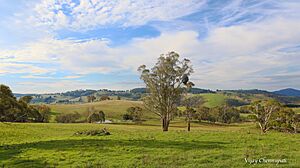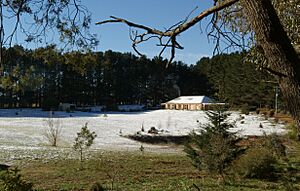Oberon, New South Wales facts for kids
Quick facts for kids OberonNew South Wales |
|||||||||
|---|---|---|---|---|---|---|---|---|---|

Oberon Street, the main street of Oberon
|
|||||||||
| Population | 3,319 (2021 census) | ||||||||
| Postcode(s) | 2787 | ||||||||
| Elevation | 1,113 m (3,652 ft) | ||||||||
| Location | |||||||||
| LGA(s) | Oberon Council | ||||||||
| County | Westmoreland | ||||||||
| State electorate(s) | Bathurst | ||||||||
| Federal Division(s) | Calare | ||||||||
|
|||||||||
Oberon is a town located within the Oberon Council local government area, in the central tablelands region of New South Wales, Australia. The main industries are farming, forestry and wood products. The town usually receives snowfall during the winter months, owing to its high elevation. At the 2021 census, Oberon had a population of 3,319 people.
It is the birthplace of Greens politician Bob Brown and Ken Sutcliffe, and former Penrith Panthers player Ray Blacklock. Oberon is located near Jenolan Caves and the Kanangra-Boyd National Park.
Contents
History
The town was permanently settled in 1839, originally named Bullock Flat, until it was renamed to Oberon in 1863. Gold was discovered on the Fish River in 1823, leading to a population boost in the area. The Oberon Council was formed in 1906. The Fish River Creek Post Office opened on 1 January 1855 and was renamed Oberon in 1866.
Heritage listings
Oberon has a number of heritage-listed sites, including:
- Blue Mountains National Park: Blue Mountains walking tracks
- 124 Oberon Street: Malachi Gilmore Memorial Hall
- Tarana-Oberon railway: Oberon railway station
- Caves Road: Jenolan Caves
Commercial area
Oberon's main streets are Carrington Avenue–Oberon Street and Ross Street. The town has several parks and sports facilities. Such parks include the Oberon Showground, Cunynghame Oval, and Apex Park. Oberon also has a museum on North Street. Oberon has a caravan park on Cunynghame Street off North Street, a hospital on North Street, a camping ground adjacent to the caravan park and a wood gallery on Oberon Street. Rotary Lookout is located on Abercrombie Road and to the east of the town is the Blenheim State Forest which includes walking tracks.
Culture
Fishing is a pastime possible at Lake Oberon and The Reef Reserve. Oberon also has a golf club off Hume Street.
South of the town is Lake Oberon, Oberon Dam and the Fish River. There is a picnic area at the dam and a reserve with walking tracks near the lake.
Rugby league football coach Craig Bellamy started his playing career with Oberon Tigers team in the 1970s.
Mayfield Garden is a popular botanical garden that covers 16 hectares (40 acres) of land. It is open daily, except on public holidays and there is an entry fee.
Transport
From 1923 to 1979, Oberon was served by a branch railway line noted for its very steep 4% gradients and very sharp 100 m radius curves. Following closure, that line was allowed to fall into disrepair, but has been under restoration by the volunteer organisation Oberon Tarana Heritage Railway since 2005.
Road access
- From Bathurst it is around 49 km (30 mi) southeast, along the sealed O'Connell Road.
- From Great Western Highway near Hartley it is around 50 km (31 mi) south-west, along the sealed Jenolan Caves and Duckmaloi Roads.
- From Goulburn it is around 140 km (87 mi) north, along the sealed Goulburn-Oberon Road.
- Relief maps of the area are provided by NSW Central Ranges Weather.
Bus connection
From 1 June 2020, there is a Monday to Friday morning bus service to Tarana station where it connects with the Bathurst Bullet train to Sydney Central with an afternoon return connection. This replaced the previous Tuesday, Friday, and Sunday coach service to Mount Victoria
While the Fentons operated Trainlink service ran on public holidays, the current system does not. As a further inconvenience, connection to the evening bus requires departure from Sydney at 3:05 pm, rather than 5:17 pm.
Weekday bus services to Bathurst are operated by Newmans, which connect with several other Trainlink rail and coach services, and with Buslines local buses.
Climate
Oberon has an oceanic climate (Cfb); with mild to warm summers, cool to cold winters averaging 0° to 9 °C and evenly-spread precipitation throughout the year. Frosts occur regularly in autumn, winter and spring, and can also occur at the height of summer. Because of its elevation and windward position on the dividing range, moderate to occasionally heavy snowfalls can be expected each year. Records ceased in 2020 due to negligence by the Bureau.
| Climate data for Oberon (Albion St, 1946–2020, rainfall to 1888); 1,088 m AMSL; 33.70° S, 149.87° E | |||||||||||||
|---|---|---|---|---|---|---|---|---|---|---|---|---|---|
| Month | Jan | Feb | Mar | Apr | May | Jun | Jul | Aug | Sep | Oct | Nov | Dec | Year |
| Record high °C (°F) | 36.9 (98.4) |
38.6 (101.5) |
32.6 (90.7) |
28.1 (82.6) |
23.1 (73.6) |
17.1 (62.8) |
16.8 (62.2) |
20.2 (68.4) |
25.6 (78.1) |
30.1 (86.2) |
35.3 (95.5) |
37.9 (100.2) |
38.6 (101.5) |
| Mean daily maximum °C (°F) | 25.1 (77.2) |
23.9 (75.0) |
21.5 (70.7) |
17.3 (63.1) |
13.2 (55.8) |
9.5 (49.1) |
8.8 (47.8) |
10.4 (50.7) |
13.8 (56.8) |
17.2 (63.0) |
20.1 (68.2) |
23.3 (73.9) |
17.0 (62.6) |
| Mean daily minimum °C (°F) | 11.1 (52.0) |
11.2 (52.2) |
9.1 (48.4) |
5.5 (41.9) |
2.6 (36.7) |
0.9 (33.6) |
−0.3 (31.5) |
0.4 (32.7) |
2.3 (36.1) |
4.8 (40.6) |
6.8 (44.2) |
9.1 (48.4) |
5.3 (41.5) |
| Record low °C (°F) | −0.5 (31.1) |
1.7 (35.1) |
−2.2 (28.0) |
−4.0 (24.8) |
−6.3 (20.7) |
−8.5 (16.7) |
−8.7 (16.3) |
−7.2 (19.0) |
−5.8 (21.6) |
−3.5 (25.7) |
−2.5 (27.5) |
−3.0 (26.6) |
−8.7 (16.3) |
| Average precipitation mm (inches) | 80.1 (3.15) |
60.9 (2.40) |
65.7 (2.59) |
57.3 (2.26) |
59.7 (2.35) |
78.5 (3.09) |
70.6 (2.78) |
74.5 (2.93) |
67.2 (2.65) |
77.8 (3.06) |
71.5 (2.81) |
74.6 (2.94) |
838.4 (33.01) |
| Average precipitation days (≥ 0.2 mm) | 7.9 | 7.5 | 7.9 | 7.8 | 9.0 | 11.7 | 11.1 | 10.8 | 9.6 | 9.5 | 8.1 | 7.7 | 108.6 |





